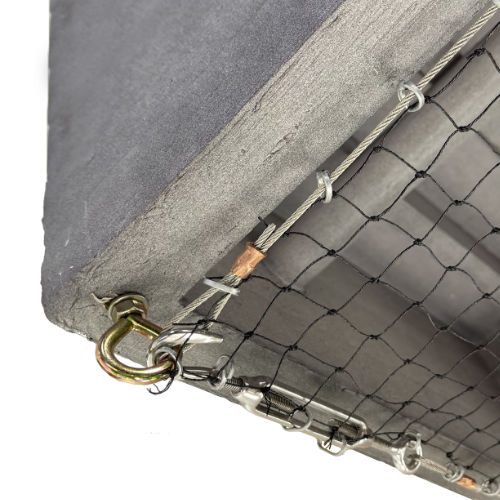Grackle Control

Recommended Products
StealthNet®
The strongest, most versatile bird exclusion system. StealthNet bird netting is an extremely effective way to deny birds access to any architecture.
Bird-Flite®
Bird-Flite® has a polycarbonate base and stainless steel spikes. It is available in three widths, to accommodate varying surfaces. Each section is 1 ft. long. Don’t use where birds are nesting.
Dura-Spike™
Economical bird spike made from 100% stainless steel. Perfect for pigeons or larger.
Bird-Shock® Flex-Track™
A low-profile, electrified, ledge deterrent system that is an effective bird deterrent against all species of birds including stubborn grackles.
Birdwire®
A spring-tensioned wire system designed to create an unstable landing area that is widely used throughout the U.S. because it is very low-profile. It carries GSA approval for historic buildings.
Audio Deterrents
Matching the noise to the bird’s behavior is key. There are two types of sonic devices: alarm/distress calls and frightening noise. Distress call devices mimic the bird’s natural communication sounds.
Visual Bird Deterrents™
Decoy owls and other predators, reflective and holographic devices such as scare tape (not aluminum foil), optical gel, our bright colors of bird scare eye balloons, fly away lasers, and other visual deterrents keep pest birds away.
Taste Deterrents™
Non-toxic taste repellents can be another effective tool when combined with audio and visual products. It is best to fill the holes with a taste repellent and either spray additional repellent over the problem and surrounding area or combine repellent with paint and cover area.
Grackle Identification
Grackles are pest birds that are boisterous, abundant members of the troupial family. Also members of this family are the blackbirds, cowbirds and orioles. Common Grackles are larger birds found all across the midwest and east coast. Boat Tailed Grackles live along the eastern and southern seacoasts while great-tailed grackles are found mostly in Texas and the south-west. Grackles are aggressive birds who will colonize in large flocks. These birds are very noisy, and their gregarious nature is very apparent when observing their roosting and nesting sites.
The Common Grackle has a green/blue or purple iridescent tinted black plumage with a glossy purplish head, neck and breast with the female of the species, slightly smaller and duller colored. Boat-tailed and great-tailed grackles have very long “v” shaped tails which crease in flight, hence the name “boat-tailed”. They are similar in color to the common grackle but are larger birds (16 inches long versus 12 inches long). Female great-tails resemble the males while female boat tails are dark brown in color Great tails differ from Boat Tail Grackles with their bright yellow eyes and more uniform color.
Grackle Damage
Grackles can cause several types of damage. As they are scavenging birds, large numbers can be found at dumpsites, food courts and other human areas where food sources are present. The resulting amount of fecal matter creates unsanitary conditions and can result in physical damage from the uric acid. They are also an agricultural pest bird because they will eat small seedlings and damage crops.
Grackle Deterrents
There are numerous products and techniques available to combat nuisance Grackles. Like fellow members of the blackbird family, noisemaker units such as the Bird Gard projecting natural distress calls and frightening sounds (selection of units depends on size of area to deter birds as well as severity of problem) plus visual scare products like Scare Eye Balloons, Octopus, and Flash Tape can be used to move them from a site. If they are too entrenched to be scared away, exclusion using 1-1/8″ StealthNet or Bird-Shock electrical track on ledges will be necessary. Grackles are too nimble for traditional mechanical ledge products. Fogging using Avian Control can also be effective in dispersing flocks.
Grackle Nesting
Grackles build a bulky yet dense nest of twigs, grasses or weeds lined with feathers, rags or dried grass. The nest may be held in place with a foundation of mud or cow dung. Grackles will nest in a variety of places from willow swamps, dense brush to tall trees with trees being the most common. Boat tail grackle nests will seldom be seen more than twenty miles from the coast.
Grackle Breeding
Grackles breed during the spring. They usually lay four to five eggs in a single brood for the year. Common grackle eggs are a pale green to light brown with purple and dark brown streaks and blotches. Boat-tailed Grackles have lighter blue to grayish eggs with dark streaks and blotches. The eggs take 14 days to incubate with the young being able to fly about three weeks later.
Grackle Cycles
Grackles have a definitive seasonal behavior. They nest and breed as one pair or in small groups in the spring time. In the fall, the birds will fall to form large colonies with the juveniles first forming the groups and later joined by the adults. These large colonies can number in the thousands. In colder, northern climates the flock will migrate south, while southern birds will stay put or move into a more urban location. These flocks will usually take over several trees or urban dwellings for their evening roosting. In the winter, their feeding site may be quite far from their roosting spot, making trapping or baiting difficult.










